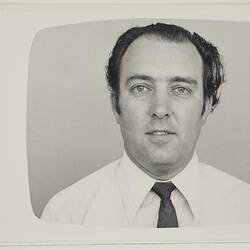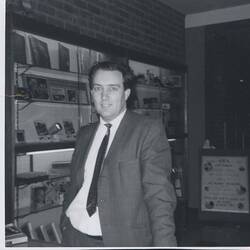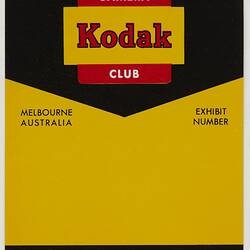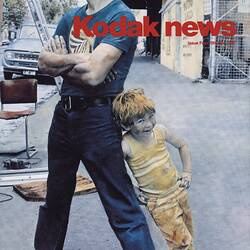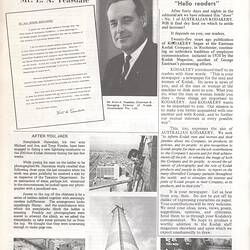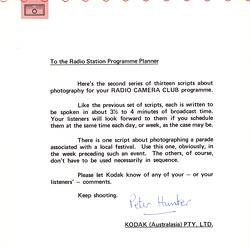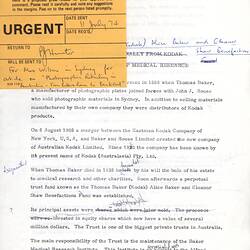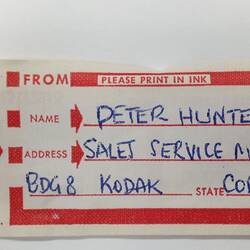Summary
A career promoting photography and the photographic industry, 1961-1995.
Peter Hunter OAM, Kodak Australasia Pty Ltd: Public Relations, 1961 - 1995
Early career in England
Peter Hunter was born in England, where he commenced his career in photography as an apprentice in the Technicolor motion picture laboratory in the 1950s. He fulfilled his obligatory national service in the Royal Air Force, where he was photographer, after which he took a job at Kodak Limited. He commenced employment at their English headquarters in Kingsway London in 1959 as a technical author. The first instruction sheet he wrote was for the new Kodachrome 2 film.
Moving to Australia as a 'ten pound Pom'
In 1961 Peter and his wife decided to take advantage of Australia's assisted immigration scheme, which provided cheap passage for British migrants:
"We were called ten pound Poms. ... We had two kids and they travelled free. And when I came to Melbourne I went straight to Kodak, their Abbotsford offices at that time. Kodak Australia had a sort of policy almost that anyone who came from Kodak in England, they would find them a job somewhere."
Sales Service Manager, Marketing Division
Peter was given the job of sales service manager in the marketing division, which was essentially an educative role for the public. Peter's responsibilities included writing technical leaflets and running the Kodak lecture service. The lectures were on motion picture films or recorded on audio tape with sets of illustrative slides. They were initially made by Eastman Kodak in America, but Peter re-wrote some of them for Australian consumers and recorded them at a radio station with professional radio announcers reading them. The lectures were available for loan to schools and camera clubs all over Australia. This was a good public relations program, as Peter comments:
"I suppose Kodak had a policy of, if you can teach people to take better photos they'll enjoy it more and they'll buy more film."
Australian Kodakery
Part of Peter's job was to set up and edit a new staff newspaper, which was called Australian Kodakery. It emulated Kodakery, the newsletter published by Eastman Kodak at its headquarters in Rochester, USA. The first issue of Australian Kodakery appeared in July 1968 and the newsletter ran until June 1985 when it was succeeded by Kodak News.
Australian Kodakery commenced with four pages, typed up by Peter's secretary on an IBM Selectric typewriter, which had the advantage of several different typefaces. The pages were laid out with a physical cut and paste. About two thousand copies were printed and distributed to employees in all the branches around Australia and also to Coburg residents. Peter was able to use some of his other writing as copy for the newsletter:
"I wrote a lot of press releases on new products and some of those just simply became articles for the newsletter. So when we brought out a new film, for example, we would describe it and I would go out with a camera somewhere and take some photos that ended up in print. It was only in black and white in those days, because making anything in colour in print was an expensive business. We had Kodakery correspondents in each department and in all the different branches and we got some interesting stories. Not always associated with the work, but someone who might have been a good sportsman or won a competition, and there would be pictures of him or her, and there would be an article, just to make people feel part of the big family."
Public Relations
Peter was the Kodak representative at photography conventions run by the Australian Photographic Society, which had a membership of about two thousand photographers, mostly amateur. Peter, who was nicknamed 'Mr Kodak', often gave a talk, and would organise a guest keynote speaker from overseas. He remembers one particular guest:
"Richard Underwood who was the chief photographer for NASA at the time of the moon landings, and he had some fantastic photos and knew each of the astronauts personally."
By the mid 1980s Peter's role had expanded and he now headed a team called the Photo Information Services Group which provided advice and support to photographers. Team members would answer queries, speak at camera clubs, judge photographic competitions, write photo journal articles and Kodak leaflets, and run guided tours of the Kodak factory for the public. Peter set up a small museum at the Coburg plant. He collected old Kodak cameras and any memorabilia people donated, and set up display cases in the canteen and the reception area of the administration building. The Kodak museum's collection was acquired by Museum Victoria after the Coburg plant closed in 2004.
Peter was also active in the staff camera club, which met regularly in the amenities building. He was president for a couple of years and became a life member. He remained a member of the club after he retired in 1995. He was awarded the Order of Australia Medal in 1990 for his services to photography, citing especially teaching photography to a group of disabled people in Yooralla.
References
Beale, Nigel, 'The History of Kodak in Australia', 1983.
HT 36735 - Oral History with Peter Hunter, interviewed by Lesley Alves 20 February 2014, and unrecorded phone interview 6 November 2014.
More Information
-
Keywords
-
Localities
-
Authors
-
Article types

